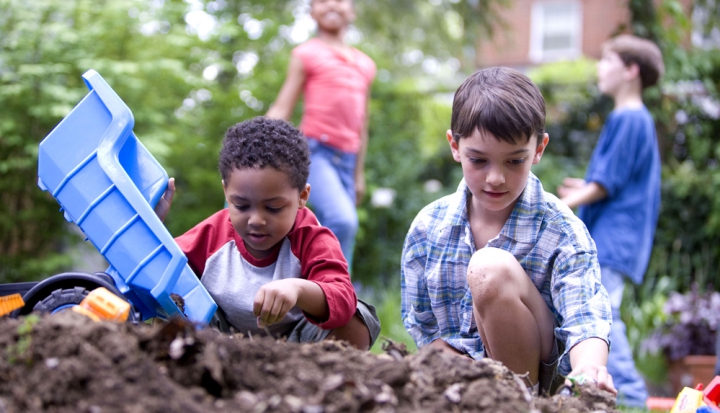White parents need to talk to their kids about race—and the sooner the better, says Jennifer Harvey, professor of religion at Drake University and author of Raising White Kids (Abingdon Press).
Explaining why it’s important to have conversations about race and racism early, Harvey borrows an analogy from psychologist Beverly Daniel Tatum comparing racism to environmental smog. Like pollution, she says, “we’re breathing [racism] in all the time. I would never let my 1-year-old go out in a toxic, smog-filled atmosphere without wearing a breathing mask, and that’s what white supremacy is. It’s in the air. If we acknowledge that there’s a smog in the air and our kids are breathing it in, the work is to figure out with our children and in our churches, ‘What does a breathing mask look like?’ ”
Harvey draws on her experiences as a parent of young children, her own history of racial justice work, and her educational background both in integrated urban schools and later in seminary to offer concrete advice to parents of white children.
How is your book based in your own experiences?
When I became a mom I realized that I needed to think through my own antiracist commitments and how they translated to raising two young white children. I also realized how few resources we have for talking about race with white children.
Post-civil rights era, most attempts to talk about race either do so through the lens of “color-blindness” or talk about valuing diversity, which is increasingly the language we use in churches and schools. But these two approaches have not created an equitable social climate and in some ways are even harmful.
What’s wrong with how we teach kids about race?
After the civil rights movement, we came to understand that you shouldn’t see someone’s race and make assumptions about who they are as a person. This is a very sound, morally logical stance.
The problem, however, is that our brains are wired to notice difference. And our kids are being raised in a society where difference matters; they recognize that. So they’re having this developmental experience where they notice difference and meanwhile adults are saying, “Don’t notice it. Doesn’t mean anything.”
Also when we tell kids to not notice race, we’re almost always saying, “Don’t notice blackness,” or “Don’t notice Latino-ness.” We’re never talking about white people. So when we say, “Oh, you’re not supposed to notice race,” there’s this insidious message that there’s somehow something wrong with color. As if we should treat a person well despite the fact that they are Black or Latino.
Valuing diversity is a significant improvement over color blindness. And it would be a great approach to racial difference if we lived in a society that was equitable. Then we could just all say, “Yeah, we’re all different. Let’s celebrate!” But we live in a society where white folks are on top in the social structures.
We can say, “Let’s value African American identity. Let’s value Latino identity. Let’s value Native American identity.” But then, if you say, “Let’s value white identity,” it’s a strange thing to say in the context of this society where there’s a white racial hierarchy.
When we tell kids to value diversity but don’t help them wrestle with what it means for children who are white, white kids end up having no meaningful way to engage in genuinely valuing diversity because they don’t know what to do with their own identity.
What is a healthy white racial identity?
When I think about what I want my two white children to be, I think about kids who are comfortable in their own bodies and yet who are also comfortable and authentically themselves engaging in multiracial spaces.
I want them never to ignore other people’s racial identities, but I also don’t want them to think, “Oh, that person’s black, so I can make these assumptions about them.”
I especially want them to feel like they have a stake in creating a more racially just society and that they have skills and contributions to bring to that project. I want to nurture that in a loving, deep way.
Those are all hard things, and there’s no perfect realization of that, but that’s the project.
How do young kids learn about racial difference?
They’ve done studies with children as young as 6 to 9 months where they put babies in a circle of adults and the babies will pause longer to look at the faces of people with a different racial identity than their own.
By ages 3 or 4, kids have started taking in all this other information, even if they don’t have language for it. For example, if they go to the pediatrician over and over and over, which young kids do, and they never see a doctor who is African American or Latino, they notice it. They might not have the words for it, but they take in that data. Over time they start to take in that all the doctors and nurses are white and all the janitorial staff are Latino—this hierarchy that exists in our social world.
Studies also show that 3- and 4-year-olds will start to play in ways that show they’re trying to make sense of this racial data. They will do things like bring in racial language when they’re fighting over a swing—all children will do this, not just white children. Or they will exclude people in their play based on racial divisions. And these kids are not coming from homes where they’re being taught explicitly racist messaging.
Three- and 4-year-olds are far too young to have discriminatory views, but they are mimicking what they see in the social world and the ways difference shows up in how our society is stratified.
It’s important for parents, therefore, to be explicit with kids and help them make sense of the racial divisions they’re seeing because otherwise they’ll just draw their own conclusions.
Can you give an example of how kids experience race in their everyday lives and how parents should respond?
My own children have two cousins who are Black. When one of my nephews was 5 years old, a kid at school had a bag of Doritos and was letting all the kids come up and smell them. I know it sounds so weird to adults, but that’s what kids do. When my nephew came up, the kid snapped the bag shut and said, “You can’t smell the Doritos. You’re Black.”
I was horrified when I heard this story. My first reaction was emotional: “Oh my gosh, I don’t want my kids, who love their cousin, to hear about this.”
But then I told myself, “Wait a second. Actually, for my kids to be good cousins and friends, this is precisely the kind of thing they need to not only understand happens, but to have parental support in processing, figuring out, ‘Oh, what would you do if you saw this happen?’ ”
I think a lot of white adults hear stories like this and assume that it’s an outlier experience. But, in fact, these kinds of incidents happen all the time among children. So while I wanted to protect my children from this horrible thing that happened to their cousin, I eventually decided to tell them what happened.
I said, “I want to talk about what you would have done if you were there and saw something like that happen.” My 4-year-old, unprompted, said, “I think the kid who did that must have been a white kid. And I think another white kid needs to stand up and say, ‘Hey, stop being mean.’ ”
It blew my mind that even at age 4 she could recognize this as racialized meanness. A lot of times white parents don’t get specific about things because we’re worried about our kids getting scared or developing negative views of people of color. But, in fact, we can nurture children’s antiracist skill set and imagination if we talk about these hard things with them.
How do you move from talking about school bullying to larger issues such as white supremacy or racial violence?
Of course, this is different for every family and every kid; we all make hard parental decisions about age-appropriate disclosures. For me, one of the things I have done is start taking my kids to protests and rallies at a very young age.
I did this not because I was excited for them to hear about African American men, women, and children being killed by police. But I knew that by the time they were old enough to have a really cognitive conversation about something such as police violence, they would’ve already missed some really important developmental opportunities to understand that racism is pervasive in our world.
When Trayvon Martin was murdered, both my kids were really little, and I took them to a protest. They were too young to talk about it; I just told them, “We’re going to be at a gathering with people who are standing up for justice.” They didn’t exactly know what justice meant, but that experience became part of their backdrop for how they moved through the world.
When my kids were a little older—my older daughter was about 4, and I had my younger child on my back in a carrier—I took them to a protest after Michael Brown was killed. We stayed on the edge of the crowd.
I told them, “A young Black teenager was hurt very badly by a police officer”—I didn’t tell them he had been killed—“and we’re going to be with other people who want that to stop and everyone to be safe.”
Partway through the protest, my daughter said, “Black people aren’t safe.” “Yeah,” I told her. And then there was one of those moments that white parents fear.
Really loudly, she said, “We’re safe because we’re white.”
I leaned down and said, “You know what, honey? You’re right, but I want to talk about that in the car. We’re not going to talk about that right here.”
Later, we had a 4-year-old-appropriate conversation about the difference between white people and Black people’s safety. I said to her, “You know when you said that we’re safe because we’re white? You’re right, that’s true. We went to that gathering because we want to be the kind of white people who say, ‘We want everyone to be safe, including Black people.’ We want everyone to be the same amount of safe.” And she was like, “Yeah, of course we want that.”
Now, at age 9, we’ve had harder conversations. She has a long-standing recognition that there is deep racial injustice in our society and that she is part of a community trying to fight against that.
How can parents navigate those awkward conversations?
That question is key because awkwardness often makes us not want to engage our kids. But I think we just have to embrace the awkwardness, just like we grow other skill sets when we’re parenting or when we’re godparents, grandparents, aunts and uncles, coaches, clergy, or anyone involved in raising children.
I think we have to recognize that it’s awkward for us because we adults live in a racially unjust system where race is really, really loaded.
When my daughter says something like, “We’re safe because we’re white,” I freak out because I have all this adult anxiety that I’m trying not to impose on my child and thus set her up to feel just as awkward about race as most adults. And the only way I start to feel less awkward over time is to dive in, embrace it, and have those conversations anyway.
I tell myself that awkwardness is a way less scary and harmful experience than violence. Violence is deadly, so the awkwardness is worth breaking a silence that can easily become deadly for other people’s children.
How can churches help kids navigate race?
Churches can help adults in their congregations have better conversations about race. Many of us still struggle with talking about race in authentic and meaningful ways, and churches can foster spaces where we can talk with and support each other through the awkward conversations. It’s a place to find other folks who have our backs, who show up for each other and who can offer supportive criticism.
Christian education programs can think of it as mission-driven work to engage congregations in dialogues about race and white anti-racism. How do we talk about difference? Do we go beyond just “God loves everybody” and can we tell our kids things like, “God is sad when difference is used to hurt some people”?
We need to create this regular conversation in our children’s programs and youth groups about the kind of racial harm and injustice our youth see. We need to create spaces for students to figure out what that means for who we are as people of faith.
I think we have to commit to making that a sustained conversation, but there’s no obvious way of knowing how to do that, because we haven’t really done it yet.
Can you summarize your book into three pieces of advice for parents and anyone else helping to raise white children?
First, never underestimate what your kids know about race or what they’re capable of in terms of antiracism. My children blow my mind when I ask them open-ended questions or invite them to talk about what they notice and what kind of world they want to live in.
The second is for adults to think of themselves as constantly modeling for children every single minute of the day. For example, it’s very common for white adults to teach children, “God loves everybody.” And then we go to a family gathering or are somewhere where someone says something racist, and we just let it slide by. Our kids notice that.
The third is to really understand and embrace the reality that this is hard. That’s because this topic is really unchartered in white communities. Communities of color have long worked on strategies and language for teaching their own children about racism and racial justice. They had to for their survival. But white communities have not yet done that work in a significant way.
We need to be compassionate with ourselves, but we also can’t leave this work undone for the next generation of white Americans. How white children learn to navigate race has a critical impact on Americans and kids of color being raised in this climate today. I really think this work is a gospel call.














Add comment